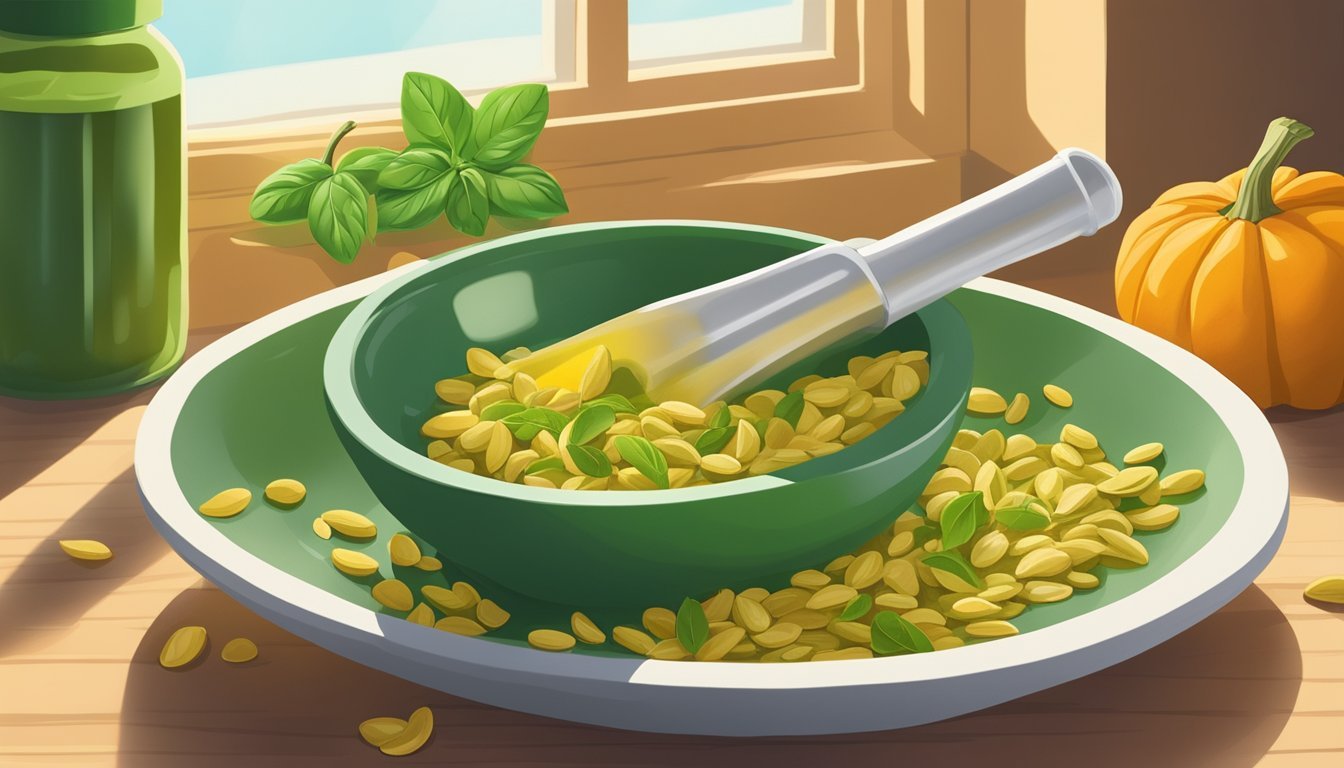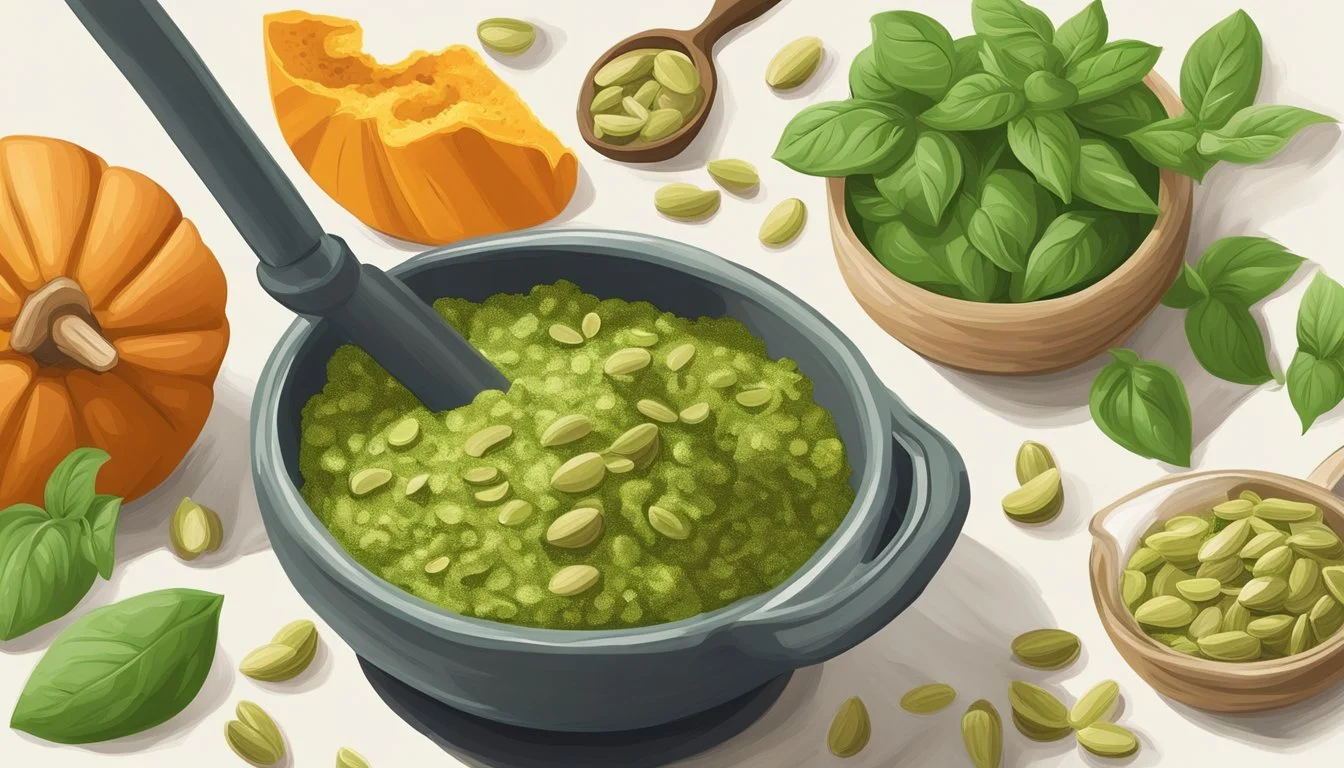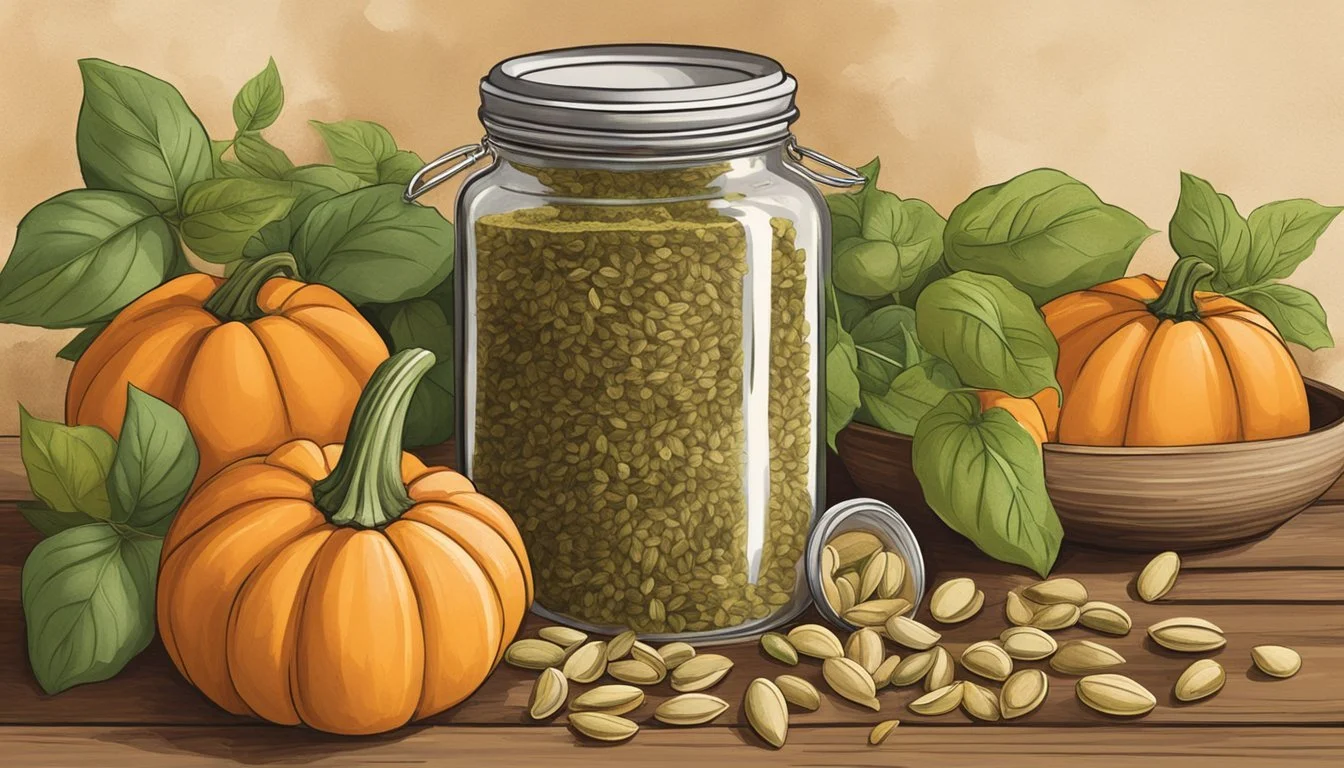Pumpkin Seed Pesto
A Versatile Ingredient for Creative Cooks
Pumpkin seed pesto emerges as an inventive twist on the classic basil-based condiment, introducing a distinctive nutty profile to the palate. This seasonal spread capitalizes on the rich, earthy flavors of toasted pumpkin seeds, melding them with the traditional ingredients of pesto to create a unique culinary experience. The versatility of pumpkin seed pesto allows it to complement a variety of dishes, from being mixed into pasta to serving as a topping for toasted bread.
While pesto is traditionally associated with pine nuts, pumpkin seeds offer an alternative that not only enhances the flavor with their inherent nuttiness but also provides additional nutritional benefits. Roasted to perfection, these seeds are combined with olive oil, garlic, and fresh herbs like basil and parsley, sometimes even blended with spinach, to produce a pesto that is both robust in taste and versatile in use.
With a focus on simple preparation, pumpkin seed pesto can be effortlessly made in a food processor. The seeds are ground and then emulsified with olive oil and other ingredients to achieve the desired consistency. The result is a spread that is as nutritious as it is flavorful, featuring a harmonious balance between the creamy texture of the oil and the crunch of the pumpkin seeds. This pesto variant stands out as an excellent choice for those seeking a non-traditional yet equally delightful version of the beloved spread.
Benefits of Pumpkin Seed Pesto
Pumpkin seed pesto offers an impressive array of health benefits, due to its rich nutritional content and compatibility with various dietary preferences.
Nutritional Profile
Pumpkin seeds are a powerhouse of nutrients. They are an excellent source of magnesium, essential for maintaining normal nerve and muscle function, as well as phosphorus, which contributes to the formation of bones and teeth. Furthermore, they provide substantial amounts of iron and zinc, which are important for a healthy immune system. Here's an overview of the nutrients found in pumpkin seeds:
Protein: Essential for muscle and tissue repair
Fiber: Aids in digestion and helps maintain a healthy weight
Vitamins: Includes vitamin E, a potent antioxidant
Minerals: A significant source of magnesium, zinc, and iron
Antioxidants: Contains antioxidants like vitamin E and manganese that protect against cellular damage
Additionally, the seeds are lower in calories and fat compared to traditional pesto ingredients like pine nuts.
Dietary Advantages
Pumpkin seed pesto is particularly accommodating for those with different dietary needs:
Vegan and Plant-Based: Offers a source of plant-based protein, ideal for those following a vegan diet.
Nut-Free: For individuals with nut allergies, pumpkin seeds provide a safe and flavorful alternative to traditional pine nuts found in pesto.
Heart Health: The use of pumpkin seeds can contribute to heart health, given their beneficial fats and low saturated fat content.
The inclusion of pumpkin seeds as the main ingredient not only imparts a rich nutty flavor but also turns this pesto into a nutritionally enriched spread suitable for various dietary plans, including vegan and nut-free diets.
Creating the Perfect Pesto
Creating the perfect Pumpkin Seed Pesto involves a harmonious blend of quality ingredients and an understanding of how to achieve the desired texture and flavor that makes this spread exceptionally delicious.
Ingredient Selection
The foundation of any pesto is its ingredients, and selecting the right ones makes all the difference. For the base, pumpkin seeds (pepitas) offer a nutty taste and a twist to the traditional pine nut ingredient. They should be toasted lightly to enhance their flavor. Fresh basil leaves are essential for that classic pesto aroma and taste. Instead of regular olive oil, opting for extra virgin olive oil lends a superior taste and quality. Garlic adds a pungent kick, and it should be fresh for the best results.
In lieu of Parmesan, those preferring a vegan choice might use nutritional yeast. It mimics the umami and richness that Parmesan cheese imparts. To elevate the taste, a squeeze of fresh lemon juice not only adds brightness but also helps to preserve the vibrant green color. Lastly, the precise amount of sea salt and pepper is crucial to balance out all the flavors.
Ingredient Suggested Quality Role in Pesto Pumpkin seeds Toasted, unsalted Base, nuttiness Basil Fresh leaves Aroma, primary flavor Olive oil Extra virgin Binding liquid, flavor Garlic Fresh cloves Spiciness, depth of flavor Parmesan/Nutritional yeast Grated / Flaked Umami, richness Lemon juice Freshly squeezed Brightness, color preservation Salt and pepper Sea salt, freshly ground pepper Seasoning
Texture and Flavor
The texture of pumpkin seed pesto is critically important; it should be creamy yet retain some texture for a pleasant mouthfeel. One achieves this through the proper use of a food processor or blender. A quick pulse technique helps incorporate air and prevents overheating the ingredients, which can lead to a loss of fresh flavors. It's important not to over-process the pesto, as the heat generated can cause the basil to wilt and the olive oil to become bitter.
Flavor balance is key in any pesto. Fresh herbs and greens like parsley, spinach, or kale can be blended with basil for a complex taste profile. Red pepper flakes add a hint of heat which complements the nuttiness of the pumpkin seeds. One must taste and adjust, adding a bit more salt, pepper, or lemon juice to perfect the spread's savoriness and zing. Each ingredient plays a part in creating a pesto that is not only flavorful but also has a depth that marries well with pastas, spreads, and marinades.
The Pesto Making Process
Making pumpkin seed pesto is a straightforward process that results in a flavorful, nutty spread. It’s a versatile recipe that allows for a degree of customization and can be stored conveniently for future use.
Step-by-Step Guide
Ingredients:
Pumpkin seeds
Garlic cloves
Olive oil
Parsley or basil leaves
Lemon juice
Grated Parmesan cheese (optional)
Salt and pepper to taste
Instructions:
Begin by preheating the oven to 350 degrees F (175 degrees C) if toasting is required. Place the pumpkin seeds on a baking sheet and toast them for approximately 5 minutes or until they're fragrant.
Transfer the toasted pumpkin seeds into a food processor along with a few cloves of garlic, depending on preference.
Pulse the food processor until the mixture reaches a coarse meal consistency, approximately 20-30 seconds.
Add fresh parsley or basil leaves, a squeeze of lemon juice, and a steady stream of olive oil while the processor is running, ensuring these ingredients are fully integrated. This should take about another 40 seconds.
For a richer pesto, incorporate grated Parmesan cheese and pulse until just combined.
Taste and season with salt and pepper accordingly.
Storage and Preservation
Short-Term:
To store the fresh pesto, transfer it to an airtight container and press a piece of plastic wrap directly onto the surface of the pesto to prevent oxidation.
The pesto can be stored in the refrigerator for up to 3 days.
Long-Term:
For longer storage, spoon the pesto into ice cube trays, cover with plastic wrap, and freeze.
Once the pesto cubes are frozen, transfer them to a freezer-safe airtight container or plastic bag. They can be kept in the freezer for several months.
Defrost as needed, and either use it directly or let it reach room temperature to restore its spreadable consistency.
Pumpkin Seed Pesto Variations
Pumpkin seed pesto offers a twist on the classic pesto with its nutty undertones and versatility in ingredients. This section explores how to customize the recipe with alternative ingredients and how to adapt it for vegan and allergy-friendly diets, while maintaining a rich, savory flavor.
Alternative Ingredients
For those looking to try different flavors or work with what they have in their pantry, pumpkin seeds can be a substitute for traditional pine nuts used in classic pesto recipes. One can also explore using walnuts or sunflower seeds as an alternative. They all lend a distinct taste and texture to the pesto.
Leafy greens like kale, spinach, and arugula are excellent additions. They not only provide a vibrant color but also add nutritional value. The following list suggests some ingredient swaps:
Seeds: Replace pumpkin seeds with sunflower seeds or walnuts for variation.
Greens: Use a blend of kale and spinach, or try arugula for a peppery kick.
Vegan and Allergy-Friendly Options
Creating a vegan pumpkin seed pesto is straightforward. Traditionally, pesto includes cheese, but for a vegan option, one could omit the cheese or opt for a plant-based substitute. To maintain the creamy texture and rich flavor, nutritional yeast can be incorporated as a cheese alternative.
Considering nut allergies, pumpkin seed pesto is an excellent nut-free option. It's important to ensure that all the other ingredients used are free from cross-contamination with nuts. Below is an example of how to adapt the recipe for these dietary needs:
Substitute cheese with nutritional yeast for a cheesy flavor without dairy.
Confirm that all ingredients, including any seed substitutions, are nut-free to cater to those with allergies.
By utilizing these variations, pumpkin seed pesto can be a robust, flavorful addition to various dishes while accommodating different dietary requirements and preferences.
Serving Suggestions
Pumpkin seed pesto offers a versatile and flavorful addition to a variety of dishes. Its rich, nutty flavor complements a range of pairings and can be used creatively across the culinary spectrum.
Pairings and Uses
Pasta: A classic choice, toss it with spaghetti or fettuccine for a hearty meal.
Salad: It can serve as a novel dressing when thinned with a bit more olive oil or vinegar.
Sandwiches: Spread on artisan bread, it enhances the flavors of turkey, chicken, or vegetable sandwiches.
Dip: Ideal as a dip for crusty bread, crackers, or sliced veggies.
Pizza: A spoonful on pizza brings a fresh twist, pairing well with both classic and contemporary toppings.
Soup: A dollop in soups like minestrone adds depth and a burst of flavor.
Chicken: When used as a marinade or topping, it offers an unexpected taste to grilled or roasted chicken. (What wine goes well with roasted chicken?)
Fish: Particularly suited for salmon, it can be used as a crust or a finishing sauce.
Toasted pumpkin seeds sprinkled on top add a delightful crunch. Roasted vegetables also benefit from a pesto drizzle, turning the simple into the sublime. With pumpkin seed pesto, the options are as limitless as one's imagination.
Tips for Perfect Pesto
Creating the ideal pumpkin seed pesto requires attention to detail and an understanding of the ingredients' interaction. Here are curated tips to ensure that one's pesto is a flavorful and textured delight.
Quality Ingredients: The pesto's flavor hinges largely on the quality of its components. Fresh basil and high-quality olive oil form the base of the taste profile. When selecting pumpkin seeds, opt for raw, unsalted ones that will be toasted to bring out their natural nuttiness.
Toasting Pumpkin Seeds: She places the pumpkin seeds on a baking sheet and toasts them at 350 degrees F for about 5 minutes. A watchful eye is key, as seeds can go from toasted to burnt quickly. Toasting not only enhances their flavor but also contributes to a more robust pesto.
Consistency:
Chunky: A brief blending period creates a coarse texture.
Smooth: Prolonged blending yields a creamy pesto.
She carefully pours in the olive oil while the food processor runs, achieving her desired consistency.
Balanced Flavors: A taste test is critical after combining the ingredients. She adjusts the seasonings, adding a pinch of salt or a squeeze of lemon juice for brightness, ensuring that the pesto is not just easy to make but also has a balanced flavor profile.
Storage Tips: Pesto can be stored in the refrigerator for up to a week. She seals it in an airtight container with a thin layer of olive oil on top to preserve its vibrant green color and freshness.
By following these tips, one can expect their homemade pumpkin seed pesto to be a seasonal spread that brings a nutty and original twist to a variety of dishes.
Health and Wellness
Pumpkin seed pesto is not only a versatile spread for breads and crackers but also an excellent addition to soups and stews, offering a boost in flavor and nutrition. Pumpkin seeds are a potent source of plant-based nutrients.
They contain healthy fats, primarily unsaturated fats, including omega-3 and omega-6 fatty acids. These fats are beneficial for heart health and can help lower bad cholesterol levels. Additionally, pumpkin seeds are a good source of antioxidants and minerals such as magnesium, zinc, and iron.
Inclusion of pumpkin seed pesto in soups and stews enhances the nutrient profile of these dishes. Zinc, for example, supports immune function, while magnesium plays an important role in bone health and energy metabolism.
Nutrient Highlights of Pumpkin Seeds:
Protein: Integral for muscle repair and growth.
Fiber: Aids in digestion and promotes satiety.
Vitamin E: A fat-soluble antioxidant that protects cells from oxidative stress.
The absence of dairy in some pumpkin seed pesto recipes also makes it a desirable choice for those who are lactose intolerant or following a vegan diet, providing a rich, nutty flavor to dishes without the use of cheese.
By incorporating pumpkin seed pesto into meals, individuals can enjoy an enjoyable way to contribute to their daily nutritional needs. It's important to note that while nutrient-dense, portion control is still key to maintaining a balanced diet.
Frequently Asked Questions
Can I substitute pumpkin seeds for pine nuts in pesto?
Yes, one can substitute pumpkin seeds for pine nuts to create a nutty and nutritious pesto.
How do I properly toast pumpkin seeds for pesto?
Preheat the oven to 350 degrees F, place the pumpkin seeds on a baking sheet, and toast for approximately 5 minutes.
Is pumpkin seed pesto vegan?
Pumpkin seed pesto can easily be made vegan by ensuring all other ingredients, such as cheese substitutes, are plant-based.
Are there nutritional benefits to pumpkin seed pesto?
Pumpkin seeds are rich in nutrients such as magnesium, iron, and antioxidants, which make the pesto both healthy and flavorful.
How do I achieve a smooth pesto texture?
Use a food processor to blend the ingredients, pulsing and scraping the sides periodically, until the desired smoothness is reached.
Does pumpkin seed pesto have a long shelf life?
Pumpkin seed pesto can be stored in the refrigerator for up to one week, or it can be frozen for longer shelf life.
Conclusion
Pumpkin seed pesto offers a robust, nutty alternative to traditional pesto, with a unique flavor profile that makes it stand out. Enriched with the goodness of pumpkin seeds, this spread provides a potent source of nutrients such as magnesium and iron.
When crafted without cheese, it's a versatile option for those on a vegan diet, with nutritional yeast often used to add a cheesy flavor while maintaining the dish's plant-based integrity. The absence of pine nuts, a staple in traditional pesto, does not diminish the richness that pumpkin seeds bring to the dish.
A few tips for perfecting pumpkin seed pesto:
Toasting the seeds can amplify their flavor.
Incorporating a steady stream of olive oil during blending helps achieve the perfect consistency.
Consistency can vary from chunky to smooth based on blending duration.
Pumpkin seed pesto is not just a seasonal delight but a culinary creation that invites personalization with various herbs, nuts, and seeds to tailor to individual palates. Whether served over pasta, spread on sandwiches, or used as a dip, it's an excellent way to incorporate more seeds into one's diet.
Ultimately, this twist on a classic adds variety to the kitchen year-round, offering both nutritional benefits and a unique taste that can elevate simple dishes to something extraordinary.
Engagement and Feedback
Pumpkin seed pesto, with its unique nutty flavor profile, has garnered attention from culinary enthusiasts across various online platforms. Food bloggers and home cooks often share their takes on this seasonal spread through social media channels such as Instagram and Pinterest, seeking to inspire others with their creative adaptations.
Instagram Engagement:
On Instagram, visual appeal is paramount. Users post vibrant photos of dishes accentuated with pumpkin seed pesto, often attracting significant engagement in the form of likes and comments. It's common for followers to inquire about recipes, which are sometimes made available through clickable links or directly as a print option in the post's description.
Pinterest Sharing:
Pinterest serves as a source for collecting and sharing recipes. Pinners can easily "pin" pumpkin seed pesto recipes onto their boards, which promotes further sharing and feedback. The comment sections under these pins capture personal experiences and suggestions for modifications, fostering a collaborative environment.
Feedback Mechanism:
Comments on social media and blogs play a pivotal role in providing real-time feedback. They often include personal anecdotes, adjustments made to the recipe, or alternative uses for the pesto. This feedback is crucial for recipe refinement and for others to gauge the versatility of pumpkin seed pesto in their cooking.
Printed Recipes:
For those who appreciate a tangible copy, print options are frequently made available on blogs. Readers appreciate the convenience of having a printed recipe at hand while cooking, which also prompts them to leave reviews or comments on the blog's webpage after trying out the recipe.
The consistent exchange of ideas and experiences through comments, social shares, and feedback has played an essential role in the rise of pumpkin seed pesto's popularity, making it a celebrated addition to the gastronomic world.







